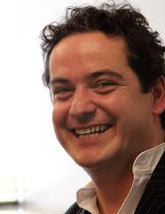

Thursday - March 25, 2010
SLAC Today is
available online at:
http://today.slac.stanford.edu
In this issue:
Clobbering Electron Clouds
Café Scientifique: Where do Stars and Galaxies Come From? with Tom Abel April 13
 |
 |
|
Thursday - March 25, 2010 |
Clobbering Electron CloudsMagnets in blue-green boxes hug the beam pipe at CesrTA. This setup tests how magnetic fields affect electron clouds.
(Photo courtesy Mark Palmer.)
Researchers at SLAC and other institutions are creating a sort of pest control for particle beams: squashing the clouds of electrons that gather in accelerators and disrupt experiments. "Some methods are already there… we know they work," said Mauro Pivi, a SLAC scientist in the Accelerator Design Department. But in order for future colliders such as the proposed International Linear Collider, or ILC, to carry off experiments of unprecedented energy, the beams must be perfect and the pipes pristine. "Even a small electron cloud could be a problem," Pivi said. Colliders delve for the universe's secrets by smashing together oppositely charged subatomic particles and examining the resulting debris. The particles accelerate toward their collision point as tightly focused bunches traveling through two long beam pipes. But particles emanating from the bunches often knock electrons from the walls of the beam pipe. These electrons bump into others. Soon the pipe hosts a cloud of electrons that ruins the beam's focus, or emittance. As a result, the colliding bunches lose their wallop. SLAC scientists and their international colleagues previously used the PEP-II collider to test several ways of dissolving the pesky clouds. To continue their work after that experiment shut down two years ago, they dissembled 82 feet of experimental beam pipes and trucked them to Ithaca, NY. They resumed their experiments at the Cornel Electron Storage Ring Test Accelerator. CesrTA is rigged to simulate a linear collider damping ring, where positively charged particles would be focused into exceptionally thin and short bunches. The work aims to improve the damping ring's performance, which could save hundreds of millions of dollars on construction. Café Scientifique: Where do Stars and Galaxies Come From? with Tom Abel April 13 At the beginning of spacetime following the Big Bang, the universe expanded rapidly. At the end of this period of rapid expansion, the universe was emitting the cosmic microwave background which marks the farthest point our telescopes can see. After cooling and becoming transparent, the universe entered an extended dark age before the formation of the first stars and galaxies. At the April Café Scientifique, Tom Abel will lead a wide ranging discussion on the universe and provide visualizations of the first structures to emerge following the dark ages. He will also address questions like:
Abel is Associate Professor of Physics in the Kavli Institute for Particle Astrophysics and Cosmology at the Stanford University Physics Department and SLAC. His research focuses on supercomputer calculations in cosmological and astrophysical systems. His visualizations and simulations of dark ages events have been featured on PBS and The Discovery Channel and in numerous newspapers and magazines, including the covers of Discover in December 2002 and of National Geographic in February 2003. The talk will take place Tuesday evening, April 13, at 6 p.m., at SRI International in Menlo Park. The talk is free and open to all. See the Café Scientifique Web site for details and directions. |
Events
Access (see all)
Announcements
|
|
| | ||
|
|
||
 <%
Response.AddHeader "Last-modified", getArticleDate()
'Response.AddHeader "Last-modified","Mon, 01 Sep 1997 01:03:33 GMT"
'Monday, December 06, 2010
%>
<%
Response.AddHeader "Last-modified", getArticleDate()
'Response.AddHeader "Last-modified","Mon, 01 Sep 1997 01:03:33 GMT"
'Monday, December 06, 2010
%>View online at http://today.slac.stanford.edu/. |
||